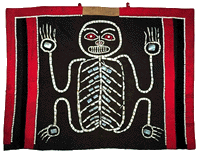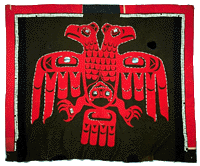
Button Blankets
 |
Trade blanket decorated with a human figure; Haida; probably acquired at Kasaan village, Alaska, ca. 1900, by George T. Emmons for the Lord Bossom collection; wool, dentalium shells, abalone shell, trade buttons. The button blanket, which came into use after European contact, has now become the most popular piece of contemporary feast attire among the people of the north coast - the Haida, Tsimshian, Tlingit and Nisga'a. At first, crest designs decorated with dentalium shells were sewn onto wool blankets acquired from maritime fur traders and later the Hudson's Bay company. By the middle of the nineteenth century, the favoured blanket was made of blue duffle, with the designs appliquéd in red stroud. Squares of abalone shell were sewn to the eyes and joints of the crest figures to reflect bits of light as the wearer danced around a fire. When pearl buttons obtained from fur traders came into use, they proliferated onto the formlines. Today, buttons are sometimes used to fill entire zones of the design elements and even the whole field of the background. |
 |
Dark blue trade blanket with the design of a double-headed Eagle appliquéd on it; Haida; Lord Bossom collection, ca. 1900; wool, dentalium shells, abalone shell, mother-of-pearl. CMC VII-B-1521 A modern potlatch can bring forward a hundred or more button blankets from the participants. At a traditional naming ceremony, it is now considered essential to present the recipient with a special blanket decorated with a family crest. A century after the button blanket was first developed, it has become a symbol of social and artistic rebirth among the Haida. One Kaigani Haida artist, Dorothy Grant, has initiated a fashion house specializing in appliquéd clothing that she labels "Feastwear". |
